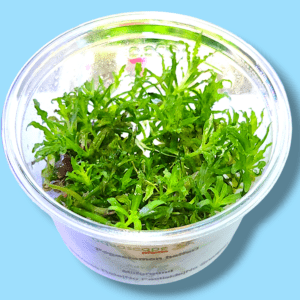Plants, Potted
Crinum Calamistratum
- Undemanding plant
- Curvy narrow leaves
- Dark green color
| Complete botanical name | Crínum calamistrátum Bogner & Heine |
| Family | Amaryllidaceae |
| Genus | Crinum |
| Difficulty | easy |
| Usage | Background, Midground, Specimen plant |
| Growth | slow |
| pH value | 5 – 8 |
| Temperature tolerance | 12 – 30°C |
| Carbonate hardness | 2 – 12°dKH |

د.إ34.43 د.إ45.00
Related products
-
Plants, Tissue Culture Cup
Aquascapeplants Pogostemon helferi
0 out of 5(0)Size: Cup
Pogostemon helferi: The Star of Your Aquascape
Description: Introducing Pogostemon helferi, also known as Downoi, an exquisite aquatic plant celebrated for its unique star-shaped leaves and compact growth. This plant is a fantastic choice for creating a dynamic and visually appealing underwater garden.
Key Features:
- Distinctive Appearance: Known for its curled, bright green leaves that form a rosette shape, adding a striking visual element to any tank.
- Ideal for Aquascaping: Perfect for foreground planting, providing a textured contrast to other plants and enhancing the overall aesthetics of your aquarium.
- Hardy and Versatile: Adapts well to various water conditions (pH 6.0-7.5, temperature 20-28°C), making it suitable for both beginners and experienced aquarists.
- Easy Propagation: Spreads through runners, allowing you to easily propagate and create a lush carpet effect in your tank.
- Available in the UAE: Readily accessible for aquarium enthusiasts in the United Arab Emirates, ensuring you can effortlessly add this stunning plant to your collection.
Common names Downoi Synonyms Anuragia helferi (Hook. f.) Raizada, Dysophylla helferi Hook. f., Eusteralis helferi (Hook. f.) Panigrahi Complete botanical name Pogostémon hélferi (Hook. f.) Press Family Lamiaceae Genus Pogostemon Difficulty medium Usage Epiphyte (growing on hardscape), Midground, Nano tanks, Foreground, group Growth medium SKU: n/a -
Sold out!Plants, Potted
Aquascapeplants Microsorum pteropus ‘Trident’ Trident Java fern
0 out of 5(0)Size: pot
Microsorum pteropus ‘Trident’ is a rare type of Java fern and there is still supply shortage and high demand in the aquarium hobby industry.
- Low growth
- Very easy to care
- narrow leave
Synonyms Microsorum pteropus ‘Fingers’ Complete botanical name Microsórum ptéropus (Blume) Copeland Family Polypodiaceae Genus Microsorum Difficulty very easy Usage Epiphyte (growing on hardscape), Midground Growth slow SKU: n/a -
Plants
Marimo Moss Ball
0 out of 5(0)- Marimo moss ball is also known as Aegagropila Linnaei
- Used in many iwagumi layouts or to even create carpet
- One of the easiest plant to maintain
- Ideal for beginners
- Velvety, Lush green balls
- The plant is very slow growing
- Can be divided into several smaller pieces
- Recommendable for shrimp tanks
SKU: n/aد.إ12.60 – د.إ21.59Price range: د.إ12.60 through د.إ21.59 This product has multiple variants. The options may be chosen on the product page - Marimo moss ball is also known as Aegagropila Linnaei
-
Sold out!Plants, Potted
Aquascapeplants Hygrophila pinnatifida
0 out of 5(0)Size: Pot
Maharashtra, Goa, Karnataka, Tamil Nadu are the states in India where Hygrophila pinnatifida is commonly found. However in the books its origin is from North India state of India, Uttar Pradesh.
- Artistic leave pattern
- To artistic to be believed real
- Can be planted in soil or attached to the hardscape
- Relatively easy to grow and care
Synonyms Nomaphila pinnatifida Dalzell, Cardanthera pinnatifida (Dalzell) Benth. ex C.B.Clarke . Complete botanical name Hygróphila pinnatífida (Dalzell) Sreem. Family Acanthaceae Genus Hygrophila Difficulty medium Usage Epiphyte (growing on hardscape), Semi-emersed plant for open tanks, Midground, Foreground, group Height 5 – 40cm Width 10 – 30cm Growth medium SKU: n/a








